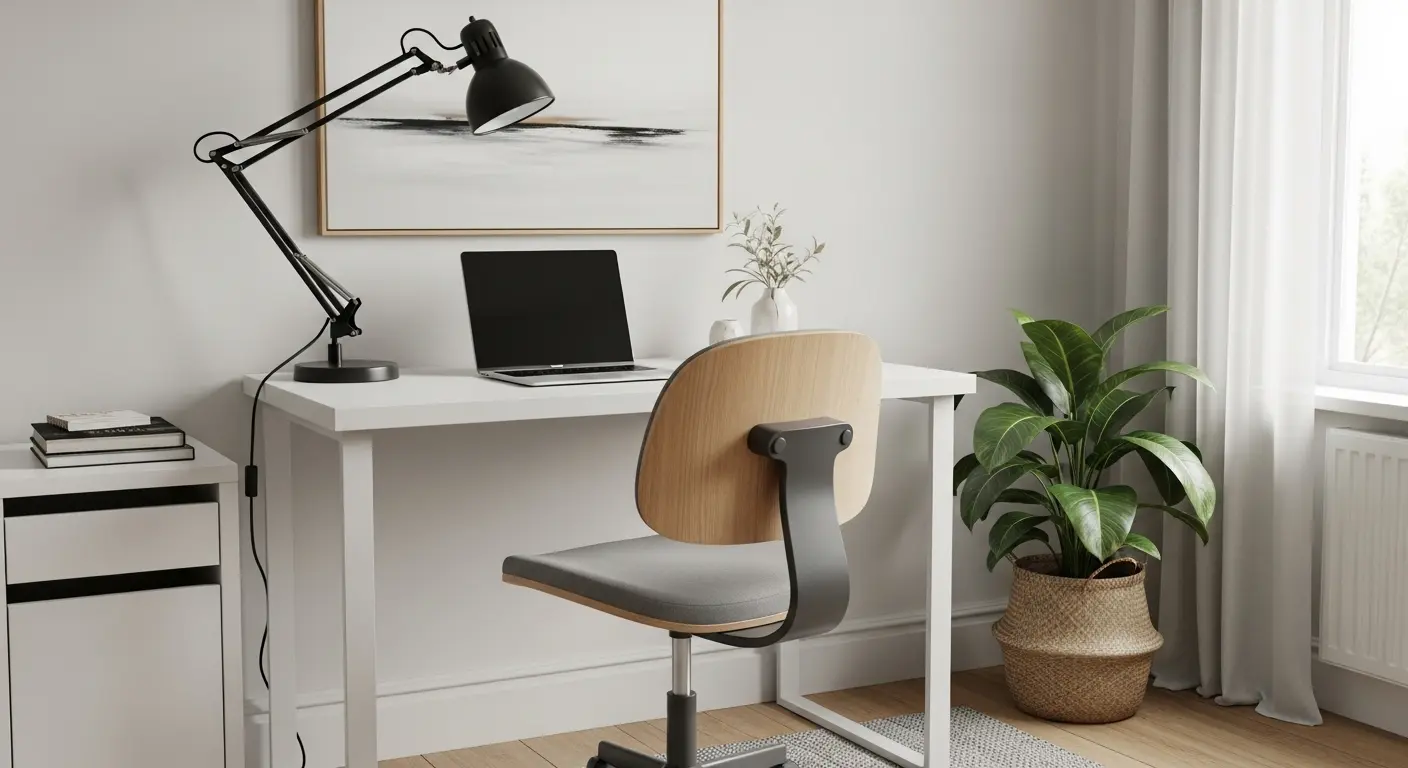
Setting up a small home office can seem like a challenge when space is limited and clutter compromises organization and productivity. After all, how do you create a functional, comfortable, and aesthetically pleasing environment in just a few square feet?
The good news is that with a minimalist approach and some strategic choices, it’s entirely possible to transform any corner into an efficient and inspiring workspace.
In this article, you’ll discover how to set up a small home office with a minimalist style, making the most of every available inch, without sacrificing comfort and functionality.
Why Minimalism is Perfect for Small Home Offices
When it comes to creating a small home office, minimalism stands out as the ideal solution. More than an aesthetic style, minimalism is a functional approach that values the essential and eliminates everything that is excessive — exactly what a compact space needs.
Benefits of simplicity in workspaces
Visually clean environments help reduce distractions and increase concentration. In a small space, every visual element competes for your attention. Therefore, fewer objects result in more focus and productivity.
Furthermore, a workspace with few items makes it easier to maintain order, making it simpler to keep the environment organized daily.
How minimalist design improves focus and productivity
Neutral colors, clean lines, and lightweight furniture are characteristics that create an atmosphere of tranquility and mental clarity. Studies in neuroscience applied to interior design show that organized spaces without visual clutter contribute to stress reduction and increased concentration capacity.
By applying minimalism to your small home office, you create an environment that stimulates focus, improves work quality, and also brings a sense of well-being.
Minimalism as a response to digital excess
In times of information overload and constant notifications, having a physical space that breathes simplicity is almost therapeutic. A minimalist home office serves as a visual reminder that less is more — even in the work routine.
Therefore, minimalism is not just a decorating choice: it’s a strategy to work better, even in a compact space.
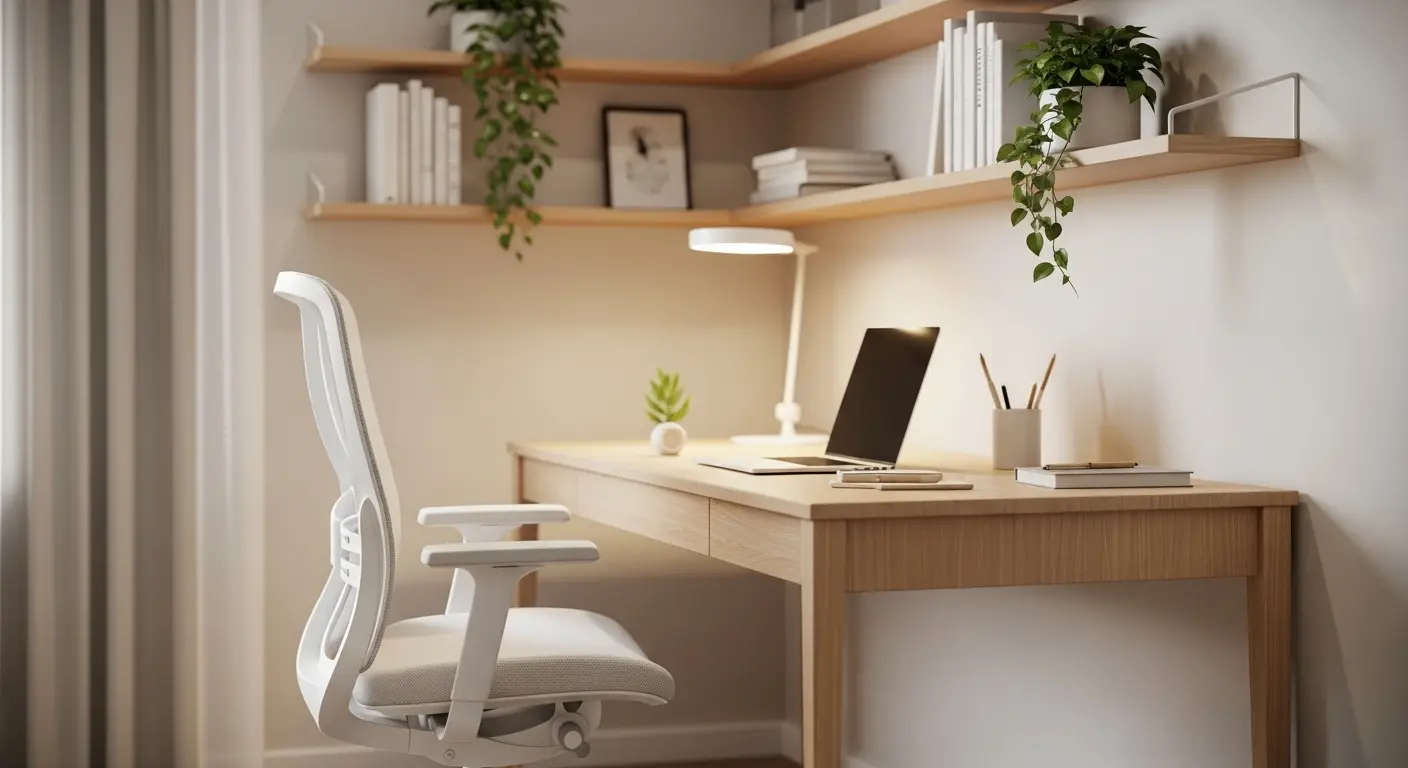
Evaluate Available Space and Define Function
Before choosing furniture or accessories for your small home office, it’s essential to understand the space you have available and clearly define how it will be used in your daily life.
Map the environment
Carefully observe the environment you intend to transform into a home office. It could be a corner of the living room, a space in the bedroom, or even an unused hallway. Measure the available size, observe natural light sources, and identify power outlets and connection points.
Note the following points:
- What is the actual size of the space?
- Is there natural light?
- Is it a quiet enough area for work?
Choose the location with the best natural lighting
If possible, opt for a location near a window. Natural light not only helps save energy but also improves productivity and well-being during working hours.
If natural lighting is limited, consider complementing it with warm, focused light fixtures to create a pleasant and functional atmosphere.
Define the functions of the space
Ask yourself: will this space only be for work? Will it also be used for studying, reading, or even online meetings? Knowing the exact function of the environment will help you choose furniture and organize the layout in the most intelligent way possible.
If the space is integrated into another environment, such as the living room or bedroom, visually delimit the workspace with rugs, colors, or even an open shelving unit that functions as a subtle divider.
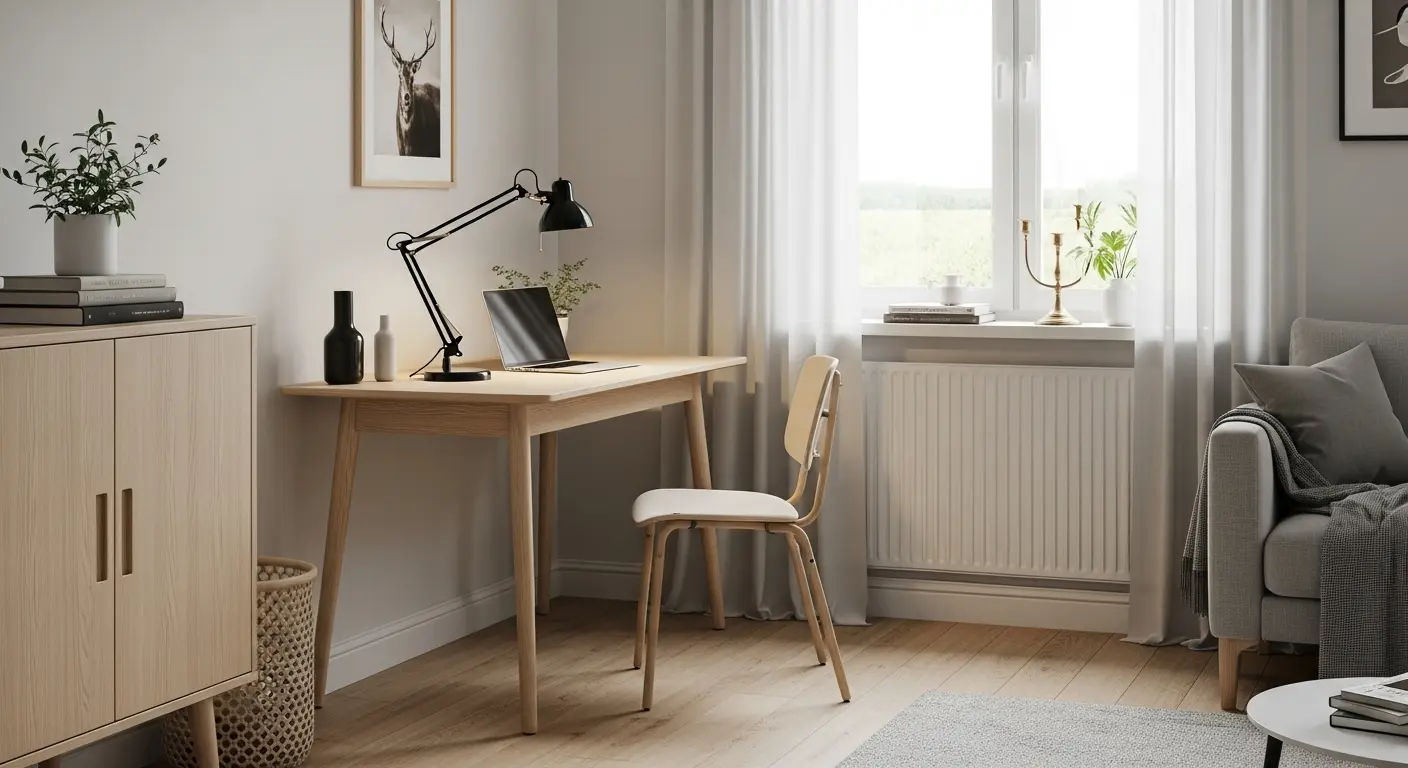
Choose Multifunctional and Compact Furniture
In a small home office, the choice of furniture makes all the difference between a functional environment and an overloaded space. Here, minimalism translates into compact, intelligent furniture that optimizes every inch.
Retractable, folding, or wall-mounted desks
If space is extremely limited, opt for folding or retractable desks that can be put away when not in use. There are models that attach directly to the wall or function as consoles that transform into a workstation.
Another functional feature is the retractable countertop, widely used in compact apartments to create a work corner without hindering circulation.
Ergonomic and compact chairs
The ideal chair for your home office needs to combine comfort and appropriate size. Prefer ergonomic models with a compact design and, if possible, with wheels or a lightweight structure to facilitate movement and mobility in the space.
Extra tip: models with mesh backs are visually lighter and work very well in small spaces.
Vertical shelving or shelves
Invest in vertical storage to keep work materials always at hand, but without compromising floor space. Floating shelves, modular niches, or tall shelving units are great allies for organizing books, documents, and decorative objects discreetly.
In addition to maximizing space utilization, these solutions reinforce the minimalist aesthetic, with clean lines and a tidy arrangement.
For more ideas, check out the article Multifunctional Furniture: The Ideal Solution for Small Apartments.
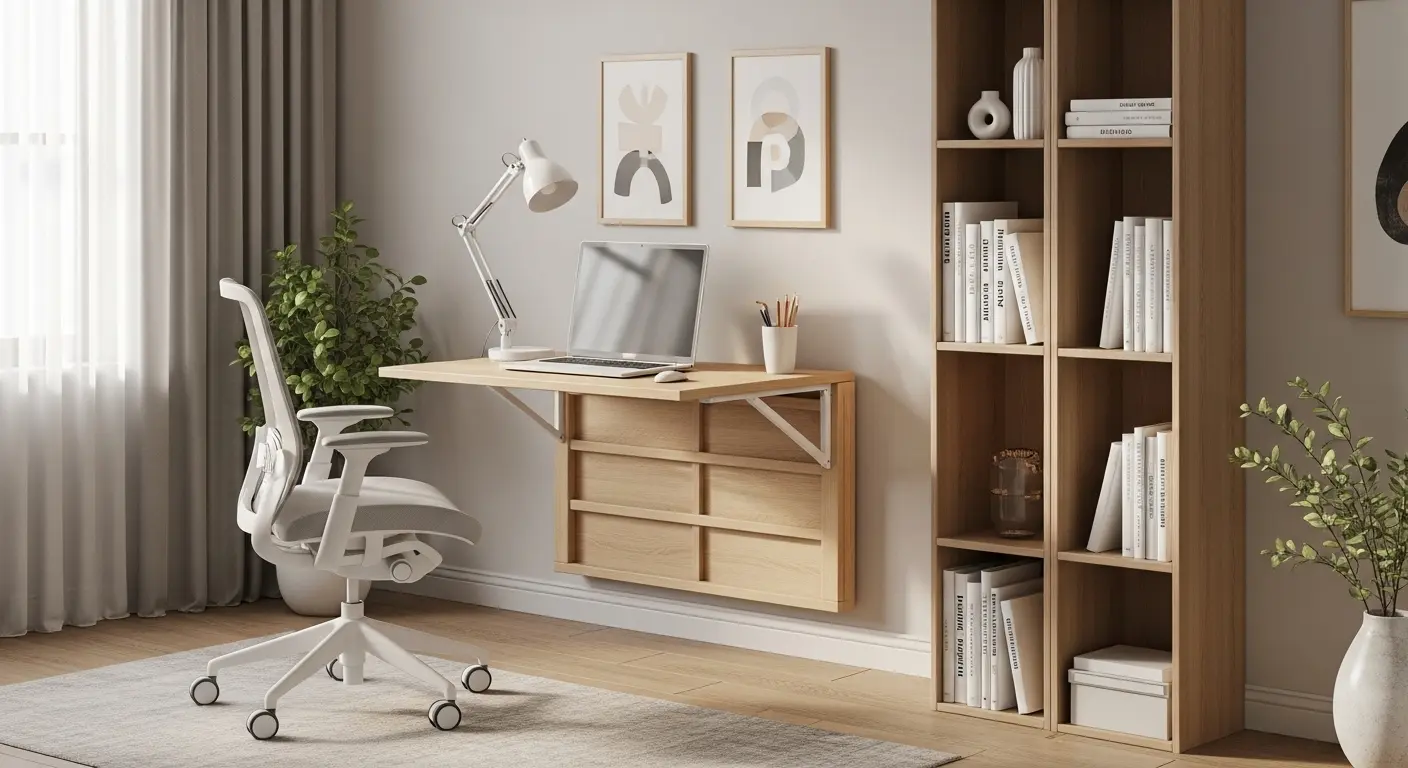
Organize Smartly: Fewer Items, More Focus
In a small home office, disorganization is the biggest enemy of functionality and minimalist aesthetics. Keeping the environment visually clean is essential to ensure focus, productivity, and well-being during work.
Minimalist organization techniques
Adopt the “one in, one out” principle: before adding any new item to your space, evaluate what can be removed or reorganized. Prioritize only what is essential for your daily work.
Use desk organizers, compact drawer units, or boxes with dividers to keep cables, papers, and accessories under control.
How to avoid accumulating papers and objects
Digitize documents whenever possible. Keep only what is necessary printed. Use trays or vertical folders to organize documents in use, and set aside one day a week to review and discard what is no longer useful.
Also avoid accumulating decorative objects. Choose only pieces that have purpose or sentimental value.
Invest in smart storage solutions
Instead of bulky drawer units, prefer narrow shelves, wall niches, or hanging drawers. These solutions help free up floor space, promoting circulation and reinforcing the minimalist aesthetic.
A good idea is to create a “clutter-free zone,” such as a discard tray or an organizing box, where you can temporarily leave papers or items that need later attention — but without cluttering the environment.
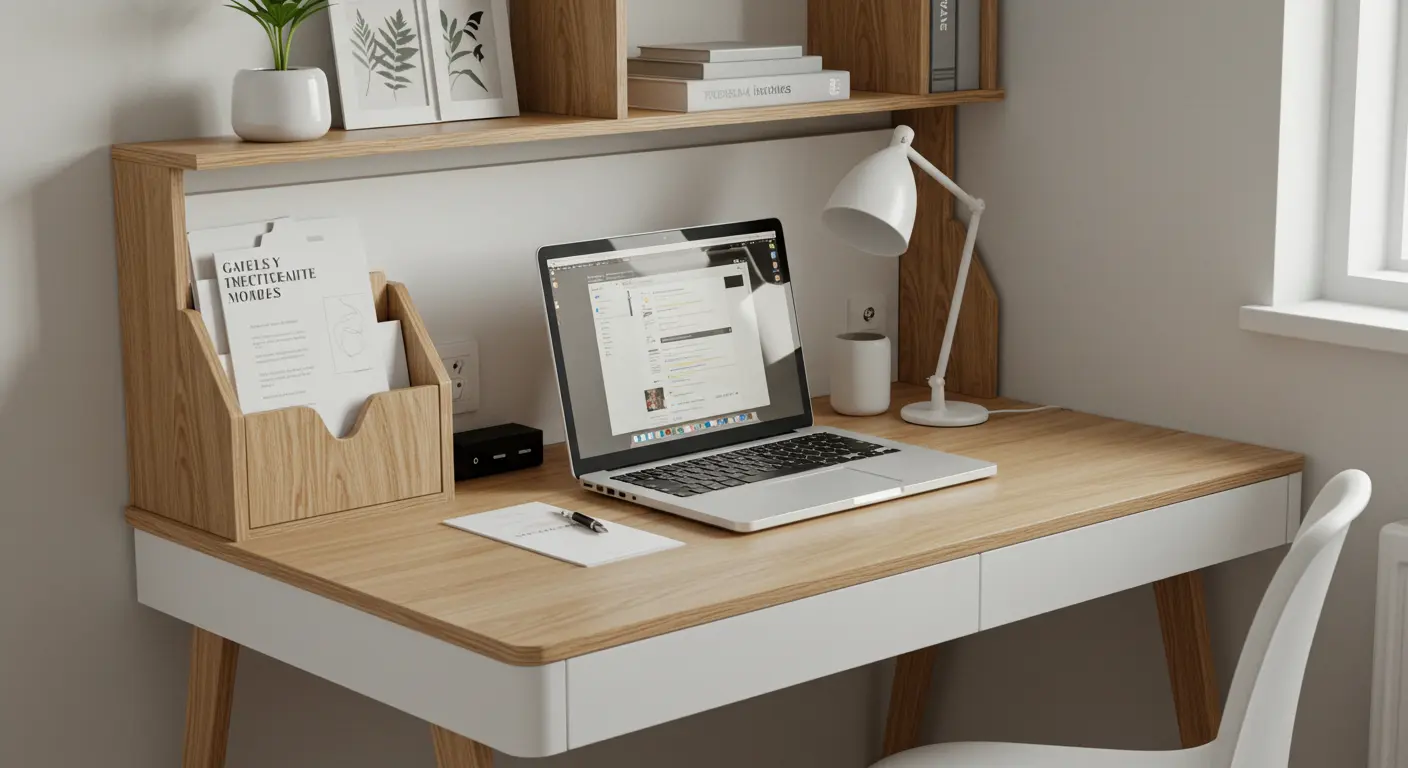
Lighting and Colors: How to Visually Expand Space
When it comes to a small home office, the choice of colors and lighting can completely transform the sense of space. A well-lit environment with an appropriate color palette not only creates visual amplitude but also more comfort and concentration during work.
Make the most of natural lighting
If possible, position your workstation near a window. Natural light reduces eye strain, improves mood, and contributes to a healthier and more productive environment.
A practical tip: use light fabric curtains, such as linen or voile, that filter light without completely blocking brightness.
Invest in good artificial lighting
If natural lighting is limited, supplement it with directional desk lamps, LED strips, or indirect light spots. Prefer bulbs with a color temperature between 3000K and 4000K, which are ideal for creating functional and comfortable lighting for reading and working.
Lights positioned on the sides avoid uncomfortable shadows over the work area.
Light colors to visually expand the environment
Neutral and light tones, such as white, beige, light gray, and sand, reflect light better and help create the illusion of a larger space. These colors also reduce visual distraction and reinforce the minimalist aesthetic.
Small pops of color can be inserted into decorative objects, such as paintings, cushions, or plants — but always in moderation.
For more palette and texture tips, check out the article: Textures and Materials in Minimalist Design that Bring Visual Comfort
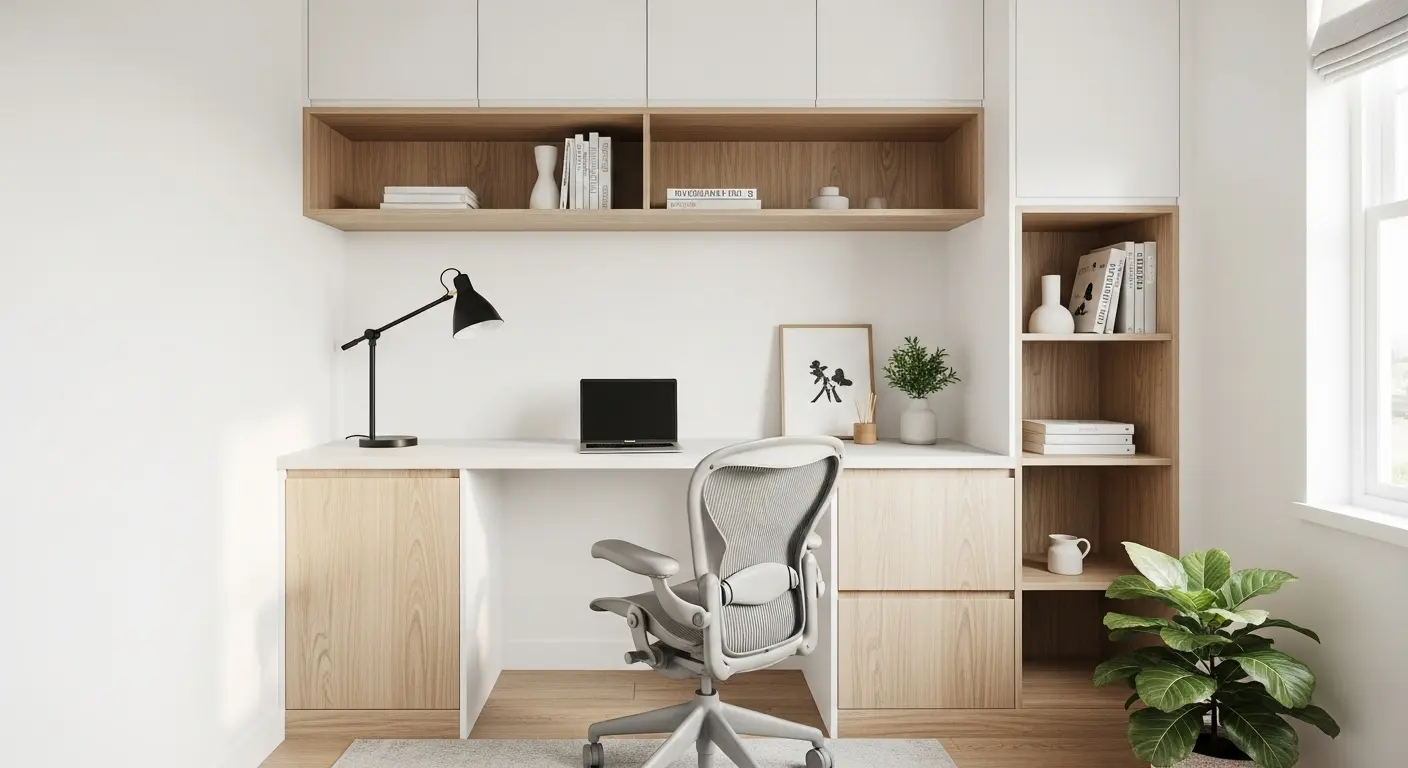
Personal Touches Without the Clutter
Having a small home office doesn’t mean giving up style or personality. On the contrary: the secret lies in choosing a few meaningful elements that bring identity to the space, without compromising the visual lightness that defines minimalism.
Decorative Items with Meaning
Include pieces that hold a story or sentimental value for you. A small framed inspirational quote, a handcrafted sculpture, or even a handmade pencil holder can transform the space and make it feel more welcoming.
Prefer clean design objects and avoid excess. The golden rule here: less, but with purpose.
Strategic Pops of Color
If your main palette is neutral (which is recommended for small spaces), add intentional touches of color through details like:
- A colorful pillow on your chair
- A small plant pot in a vibrant tone
- An art piece with a bold background
This way, you create focal points that bring energy without overwhelming the space.
Plants and Indirect Lighting
Plants are great for adding life to your home office. Species like pothos, ZZ plants, or succulents take up little space and require minimal care.
Also, consider adding a minimalist-designed lamp with indirect lighting to help create a cozy atmosphere during moments of focus.
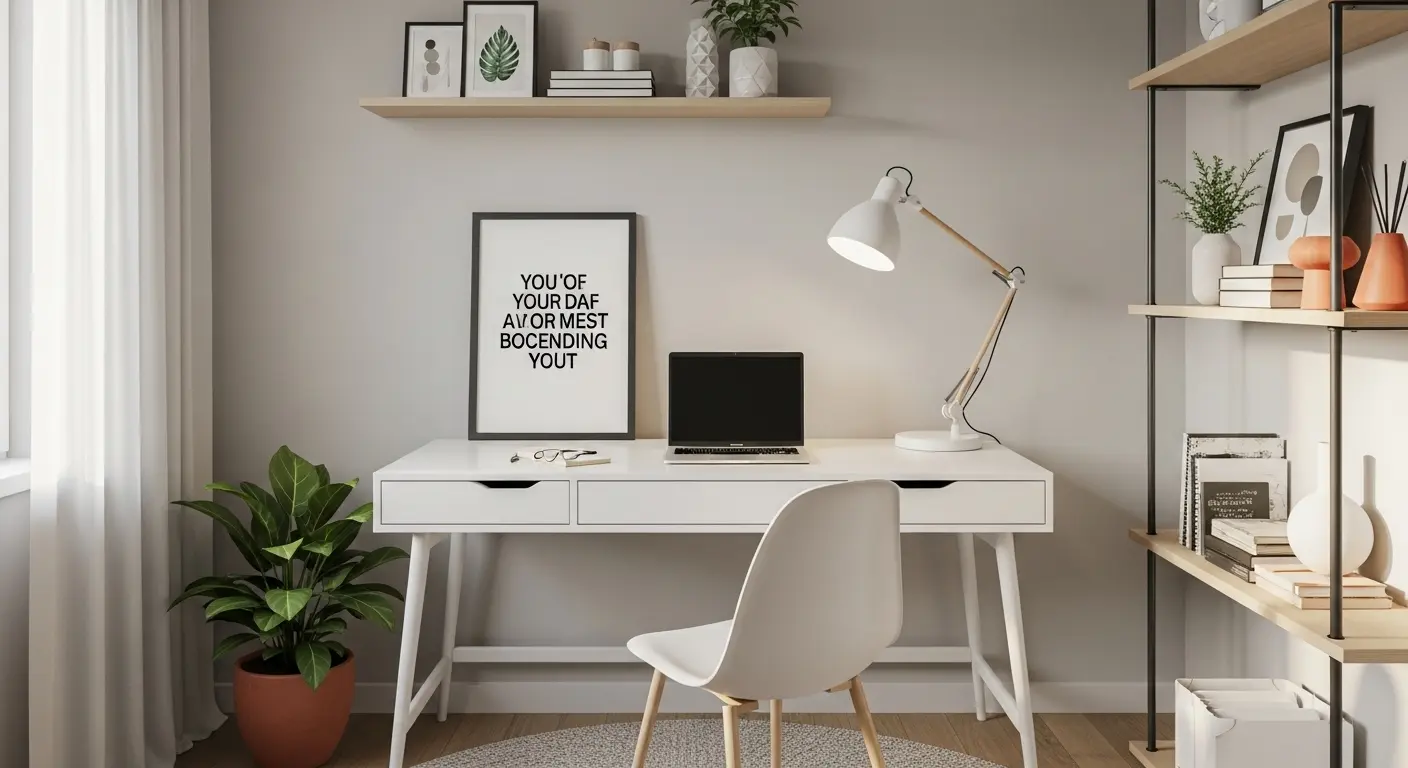
Extra Tips for Maintaining Functionality Day-to-Day
Creating a small, minimalist, and functional home office is just the first step. The real challenge is keeping the space organized, light, and efficient in everyday use.
Establish a Weekly Organization Routine
Set aside a few minutes at the end of each week to review papers, organize materials, and clear off your desk surface. This simple habit prevents clutter build-up and helps maintain the visual clarity that minimalism values.
Always keep a box or drawer available to temporarily store documents or objects waiting to be sorted.
Adapt the Space as Your Needs Change
If your routine changes, your space can—and should—change too. Your home office needs to be flexible enough to adapt to new scenarios: whether it’s shifting to study, reading, virtual meetings, or adjustments in family routines.
That’s why it’s best to choose modular furniture, adjustable shelves, and lightweight, easy-to-move elements
Let Minimalist Aesthetics Be Your Guide
Over time, it’s natural to accumulate new items. That’s why whenever you add something new, ask yourself the minimalist’s key question:
“Does this item have a clear function or purpose here?”
This reflection helps you maintain visual balance and prevents the space from losing its light and organized identity.
Comparison Table: Traditional vs. Minimalist Solutions for a Small Home Office
Choosing the right furniture and organization solutions is key to maintaining both functionality and lightness in a small home office. See below for some smart swaps:
| Item | Traditional Solution | Minimalist Alternative |
|---|---|---|
| Desk | Large, bulky writing desk | Wall-mounted, foldable, or retractable desk |
| Chair | Oversized padded chair | Compact ergonomic chair with light design |
| Bookshelf | Tall, enclosed shelving unit | Open shelves or vertical wall niches |
| Lighting | Heavy central chandelier | Desk lamp or directional spotlights |
| Organization | Large floor-standing drawers | Wall-mounted or hanging organizers |
These substitutions not only optimize physical space but also reinforce the functional minimalism concept, leaving the environment visually lighter and more conducive to concentration.
Conclusion: A Small Home Office Can Be Big on Functionality
Creating a small home office with a minimalist style is not just about aesthetics—it’s about quality of life. When you choose to simplify, prioritize the essentials, and eliminate excess, your workspace becomes a true ally for your productivity and well-being.
By applying the tips from this article—from choosing multifunctional furniture and a neutral color palette, to taking care of visual organization—you’ll transform even the smallest corner of your home into a space that inspires focus, lightness, and creativity.
Remember: It’s not the size that determines the efficiency of a home office, but how you organize and use every inch of it.
Now it’s your turn! Choose one tip to start today, reorganize your space, and experience the benefits of working in a minimalist and functional environment.
